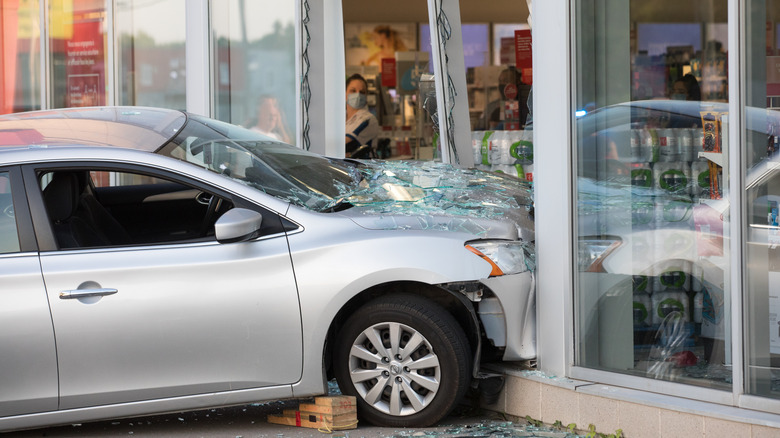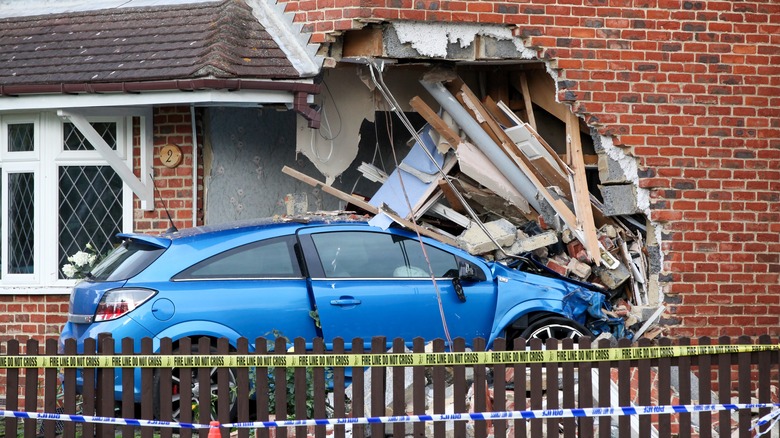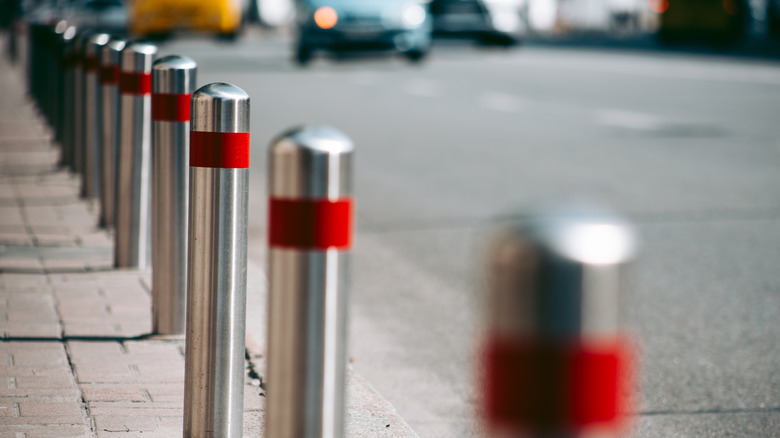You Won't Believe How Many Accidents Involve Cars Crashing Into Buildings Every Day
Sidewalks are notorious for lulling pedestrians into a false sense of security. However, danger lurks even after pedestrians enter a building. According to the Storefront Safety Council, the number of vehicles that crash into buildings daily is much higher than you might think.
Mark Wright, the co-founder of the Storefront Safety Council, knows the dangers of cars crashing into buildings. According to WTOP News, Wright was shopping at a 7-Eleven when a driver confused her car's brake pedal with the accelerator. Wright remembers, "a split second later, my hands were on the hood of her car as I was being crashed backward into the store. And luckily, her vehicle did come to a stop." His recovery required several surgeries over roughly nine months. Wright is one of many people who have found themselves the survivors of car accidents, even though they were inside a building.
According to the insurance company, Connect, most incidents that involve cars crashing into buildings occur because of pedal error, as was the case with Wright's injury. WTOP News explains that pedal error can include both instances in which the driver confuses the accelerator for the break or mixes up the drive and reverse gears. The frequency with which these incidents occur is especially concerning since many streetside outdoor dining facilities — which cropped up during the pandemic — position patrons near moving vehicles.
Nearly 100 incidents happen every day in America
Mark Wright's co-founder of Storefront Safety Council, Rob Reiter, was also inspired by a specific incident (via CStore Decisions). In 2003, a driver accidentally killed 10 people at a farmer's market in Santa Monica. The tragedy prompted Reiter to raise awareness about car accidents off the road. According to their data, nearly 100 incidents involving a car crashing into a building happen daily in the U.S. They estimate that 2,600 deaths result from these incidents each year and that at least 16,000 people are injured on an annual basis.
Connect reports that the top three locations for these incidents are retail stores, restaurants, and commercial buildings. The three most common reasons for such horrific accidents include driver error, pedal error, and DUIs. Surprisingly, these crashes most often occur when the driver is going straight or parking. The two groups of people most likely to have pedal errors are teens and seniors. Connect expects this kind of crash to increase since the number of senior drivers on the road will double by 2060.
However, some are skeptical of the Storefront Safety Council's data, says Slate. Many cite that Reiter has ties to Calpipe, his former employer and producer of the bollards that act as safety barriers between cars and pedestrians. Others express concerns about the vast difference between Reiter's numbers and those of the National Highway Safety Transportation Administration.
Skeptics and Solutions
Angie Schmitt, the author of "Right of Way," helps explain this discrepancy between the Storefront Safety Council's numbers and that of government reports, writes Slate. Schmitt says, "Official pedestrian fatalities leave out a few thousand fatalities that happen on private property." Even the Storefront Safety Council acknowledges that their reports are less than perfect since the council relies on media reports for their data (via WTOP News).
In fact, the group is seeking more credibility through outside audits. In mid-2022, CHC Global, a risk management firm associated with the insurance market Lloyd's of London, reviewed Reiter's information, confirming that his data was accurate and reliable. Surprisingly, CHC Global guesses that the Storefront Safety Council is underreporting the actual number of incidents. These findings only emphasize the need for better safety measures to protect both pedestrians and drivers.
Stores can make a difference by taking preventative measures, such as designing parking lots without building-facing parking spots or roads (via Connect). Physical barriers can also help, especially around pedestrian walkways and accessible parking spaces. Davis Law Group, P.S. adds that local transportation agencies can take measures to increase general road safety. Safety improvement opportunities include lower speed limits, proper signage, and traffic signals. Reiter tells CStore Decisions that a significant issue is the lack of an overarching safety code to address these accidents. For now, we could all benefit from increased awareness about the potential dangers within and around storefronts.


